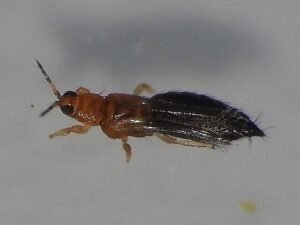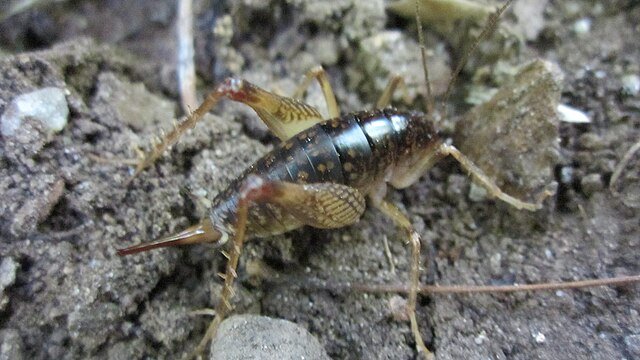Thrips (Thysanoptera): Identification, Damage & Effective Control
 Among the smallest yet most frustrating plant pests, thrips (order Thysanoptera) are known for their stealthy feeding and serious plant damage. These slender insects measure just 1–2 millimeters long but can cause extensive harm to crops, ornamental plants, and even greenhouse systems.
Among the smallest yet most frustrating plant pests, thrips (order Thysanoptera) are known for their stealthy feeding and serious plant damage. These slender insects measure just 1–2 millimeters long but can cause extensive harm to crops, ornamental plants, and even greenhouse systems.
I’ve seen entire greenhouse rows collapse from Frankliniella occidentalis (the Western flower thrips) infestations in just a few weeks. These insects feed by puncturing plant cells and sucking out their contents, leaving behind silvery scars and deformed leaves.
Thrips are widespread — from the United States and Europe to Australia and Asia — and they can attack everything from roses and tomatoes to citrus, onions, and orchids.
Understanding how thrips live, reproduce, and spread is key to effective control, whether you’re managing a home garden, greenhouse, or commercial farm.
Identification
Thrips are tiny, elongated insects with narrow, fringed wings (hence the name Thysanoptera, meaning “fringed wing”). Most are yellow, brown, or black, with adults barely visible to the naked eye.
Key characteristics:
Size: 1–2 mm (some species smaller than a grain of sand).
Shape: Slender, cigar-shaped body.
Wings: Feather-like fringes used for gliding rather than flying.
Mouthparts: Asymmetrical — adapted for puncturing and sucking.
Movement: Quick and erratic, often hiding in buds, flowers, or leaf folds.
Common pest species include:
Frankliniella occidentalis (Western flower thrips)
Thrips tabaci (Onion thrips)
Scirtothrips dorsalis (Chilli thrips)
Heliothrips haemorrhoidalis (Greenhouse thrips)
Their small size and tendency to hide make them hard to detect until visible plant damage appears.
Biology and Ecology
Thrips undergo an unusual life cycle — a mix of incomplete and complete metamorphosis.
Life stages:
Eggs: Inserted directly into plant tissue.
Larvae: Feed on plant sap for several days.
Prepupae and pupae: Fall to the soil or leaf litter to develop into adults.
Adults: Live 30–45 days and reproduce rapidly.
A single female thrips can produce up to 80 offspring, often without mating (a process called parthenogenesis).
Thrips thrive in warm, dry conditions and populations explode in spring and summer — especially in greenhouses and indoor gardens. Their adaptability allows them to survive outdoors, on ornamentals, crops, and even weeds that serve as reservoirs.
Global Distribution
Thrips are cosmopolitan — found on every continent except Antarctica.
North America: Frankliniella occidentalis dominates greenhouse crops.
Europe: Thrips tabaci common in onions, leeks, and garlic fields.
Asia: Scirtothrips dorsalis causes severe citrus and chilli damage.
Australia: Several native species affect native and ornamental flora.
Because of their global reach, thrips are one of the most regulated pests in international plant trade. Quarantine protocols often require inspection and fumigation before export.
Risks and Damage
Thrips don’t just suck sap — they destroy plant cells. The results are visible and economically significant.
Typical damage includes:
Silver or bronze patches on leaves.
Distorted buds, curled leaves, and scarred petals.
Reduced fruit yield and poor quality.
Transmission of plant viruses such as Tomato spotted wilt virus (TSWV) and Impatiens necrotic spot virus (INSV).
In greenhouses, thrips can move from one crop to another within hours, spreading viral diseases faster than most insects.
They also leave behind tiny black fecal dots, a sure diagnostic sign of feeding activity.
Signs of Infestation
Spotting thrips early is difficult — but not impossible. Here’s what to look for:
Silvery streaks or speckling on leaves.
Buds that fail to open or flowers with brown edges.
Deformed or undersized fruits and leaves.
Presence of small, fast-moving insects on undersides of leaves.
Yellow or blue sticky traps filled with tiny, elongated insects.
If you tap a leaf over white paper and see small, darting insects — you’ve got thrips.
Control Methods
Effective thrips control requires a mix of physical, biological, and chemical approaches.
1. Cultural Control
Remove weeds and infested plant debris.
Avoid over-fertilizing with nitrogen, which makes plants more attractive.
Rotate crops and rest soil between planting cycles.
2. Physical Control
Use blue sticky traps to monitor adult populations.
Install fine mesh screens on vents and windows.
Prune heavily infested plant parts.
3. Biological Control
Several natural enemies help suppress thrips populations:
Orius insidiosus (minute pirate bug) – predates larvae and adults.
Amblyseius cucumeris and Neoseiulus barkeri – predatory mites effective in greenhouses.
Beauveria bassiana – entomopathogenic fungus used in organic IPM.
4. Chemical Control
When populations explode, selective insecticides may be required.
Use insecticides, or insecticidal soaps, rotating products to prevent resistance.
Always ask help from a licensed pest control professional who will apply the right chemicals where the thrips hide.
Advanced Approaches
Professional pest control often combines Integrated Pest Management (IPM) with environmental modification:
Monitoring thresholds to decide when to spray.
Combining beneficial insects with selective chemicals.
Using reflective mulch films to repel thrips.
Implementing strict greenhouse hygiene and air circulation.
In large-scale agriculture, biological programs using predatory mites and parasitoids are increasingly replacing chemical sprays due to resistance issues.
Cultural and Historical Context
Thrips may be tiny, but they’ve been recorded since the 18th century, first described by Carl Linnaeus. Farmers have battled them for centuries, with early control attempts using tobacco extracts and sulfur dust.
In modern times, thrips are considered “silent spreaders” of plant viruses — a major problem for greenhouse economies in Spain, the Netherlands, and California.
Interestingly, thrips also play minor roles in pollination, especially in tropical ecosystems. Not every species is a pest, but those that are can devastate entire crops if ignored.
FAQ About Thrips
Q1: Do thrips bite humans?
No, thrips don’t feed on blood. They may occasionally probe human skin, causing minor irritation, but they don’t bite or transmit human diseases.
Q2: How do I get rid of thrips naturally?
Try spraying neem oil, insecticidal soap, or using beneficial insects like Orius insidiosus. Always repeat applications weekly until populations drop.
Q3: Why are thrips so hard to control?
They hide inside buds and folds, reproduce fast, and can develop resistance to insecticides — that’s why IPM is essential.
Q4: Can thrips kill plants?
Yes. Heavy infestations weaken plants, deform flowers, and transmit deadly viruses like TSWV and INSV.
Q5: Are thrips the same as aphids?
No. Aphids are soft-bodied sap feeders; thrips are slender, fast, and often winged. Both damage plants but require different treatments.
Q6: How can I prevent thrips in a greenhouse?
Use sticky traps, avoid bringing in infested plants, and release predatory mites early in the season.
Final Thoughts
Thrips (Thysanoptera) are one of the most underestimated plant pests. They don’t chew leaves or cause dramatic holes like caterpillars, but their subtle feeding can devastate a crop over time. Whether it’s Frankliniella occidentalis, Thrips tabaci, or Scirtothrips dorsalis, these insects thrive on neglect and warm, sheltered conditions.
From my own field experience, I’ve seen that the best thrips control isn’t a single spray — it’s prevention through vigilance. Regular monitoring with sticky traps, sanitation, and the use of beneficial predators can keep populations in check long before they explode.
If you notice silvering leaves or distorted buds, act immediately. Don’t rely solely on chemical treatments — they can make things worse by killing natural enemies. An integrated pest management (IPM) plan remains the most reliable long-term solution for both farmers and home gardeners.
Disclaimer
This article is for informational purposes only. Pest control laws and approved chemicals vary by country. For best results and legal safety, we strongly recommend contacting a licensed pest control professional in your local area. Always make sure that the pest control technician is properly certified or licensed, depending on your country’s regulations. It’s important to confirm that they only use approved products and apply them exactly as instructed on the product label. In most places in Europe, UK, or USA, following label directions is not just best practice—it’s the law.
Author
Nasos Iliopoulos
BSc Agronomist & Certified Pest Control Expert
Scientific Director – Advance Services (Athens, Greece)
Licensed Pest Control Business – Ministry of Rural Development & Food (GR)
References
University of Maryland - Thrips in Home Gardens
University of Minnesota - Thrips

